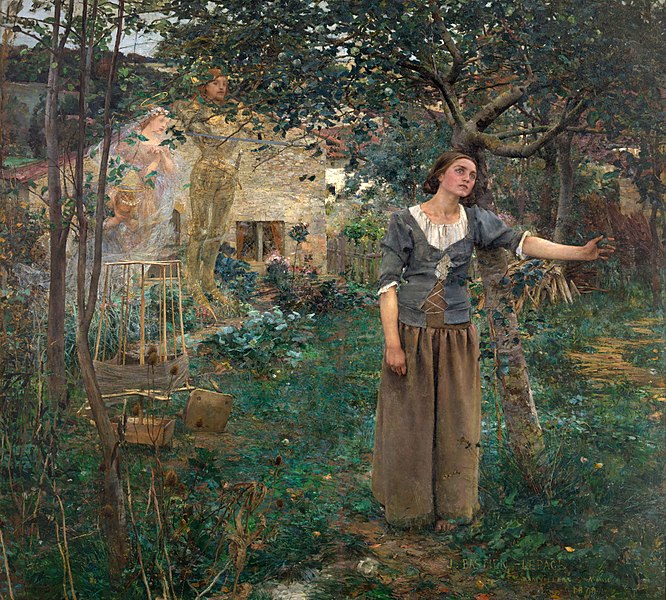Polished sword and shining armor
mean nothing to the people of France
They are losing.
There is no hope.
Death is everywhere.
Many had to die for Joan of Arc.
She caused death.
She extinguished hope
in the faces of her enemies.
She lost her fear
and passed it to her opponents.
Why was Joan of Arc slain?
She was the hope,
She was the death,
She was lost in the flames of war.
A hardened heart does not see the beauty
in the pain of her passing.
Harden your hearts,
Joan wants no beauty in her,
but in the people for whom she fought.*
Joan of Arc is probably one of the best-known non-Biblical saints, those who have been canonized by the Roman Catholic Church (and accepted as such by Anglicans and others), but who are not mentioned in the Bible, like Sts Matthew, Mark, Luke, John, and Paul. Even the small town where I grew up had a Roman Catholic Church named after her. Come to think of it; I never heard of her until I met a few people who attended there. That must have been during my elementary school years. I still didn’t know her whole story, though.
James Kiefer has written a brief biography of her that covers her life thoroughly. It describes her many roles in history: a virgin, devout Christian, a visionary, one who inspired thousands to go to battle. The English captured her as an enemy, sent her to trial, and condemned her as a witch and a heretic. The spot is marked upon which she met her death by being burned alive in Rouen at the Place du Vieux Marché.
One thing that inspired, alienated, and then restored her in the eyes of the people was that she claimed guidance from God by way of Sts Michael the Archangel, Margaret of Antioch, and Catherine of Alexandria, who spoke to her, bearing God’s messages for her to follow. It was probably difficult for some to believe as real as many of those who proclaimed or exhibited visions, auditory signals, and strange behavior were considered possessed by Satan or mad. Often isolated, these souls could be relegated to dungeons or remote locations. Even then, some were secretly visited by townsfolk who sought potions, herbs, or prophetic words.
Aguayo’s poem portrays Joan as one who spoke to both sides, the English and the French. Her words and actions were meant to encourage the French. Moreover, she wanted to increase the faith of those who followed her as a symbol. She dressed as a man in armor and hid her feminine gender to be more convincing. After all, who would listen to a young maid who claimed to speak with saints and archangels? A man was much more believable in such matters. Today we would just call them madmen or insane and ignore them or shun them lest such a disease or disorder infect us. It’s incredible to me how many people still believe mental illness is contagious, like measles or COVID-19.
The thing that speaks to me about Aguayo’s poem is that it speaks from a perspective of a deeply empathetic person, one who sees life differently through the lenses of his own mental illness and who has a sincere faith. I especially love the last two lines, “Joan wants no beauty in her,/but in the people for whom for whom she fought.” For Joan, it was not about fame or glory, but for her country and country’s folk. Her voices told her what needed to be done and trusted her to pass on the message. She believed them in turn as genuine messengers from God, and, as such, she obeyed them.
So many, in the depth of their mental illness, cannot believe in God, much less have the empathy for others that Aguayo does. While he has bad times, his faith appears to help him and inspires his writing, which he shares with us. Perhaps he is a voice of vision and hope for us and also a reminder that the mentally ill are not defective people, although various medications and therapies can help them if not cure them. They are people, just like us, who fight depressions and rage and withdrawal, just perhaps to a greater extent probably. They are beloved children of God, as all of us are, and as precious in God’s sight. He, like Joan, has messages to share with us, messages to which we need to listen, heed, and act on.
Joan didn’t win the battles alone, but she surely endured her death alone. Even if I am in the midst of a crowd, at the moment of my death, I will be alone except for God. I will never be a symbol for a group or a nation, undoubtedly never be a saint, or anything other than just a human being. Perhaps what God wants me to learn from Aguayo, Joan, and the poem, is to look at everyone as a child of God, equal and loved, no matter what their exceptionalities or deficiencies may be.
God bless.
*Aguayo, Roy Samuel. 2017. Havoc & Heaven A Collection of Poems (42). Used by permission of the author.
Image: Joan Of Arc. Artist: Jules Bastien-Lepage (1879). Metropolitan Museum of Art Collection. Found at Wikimedia Commons.

